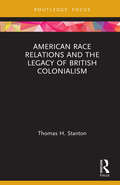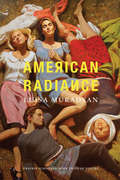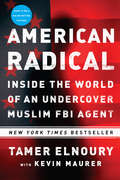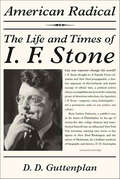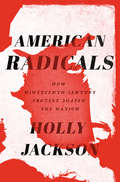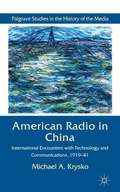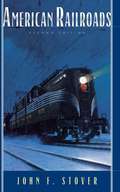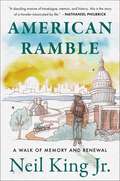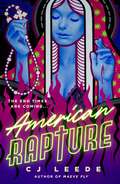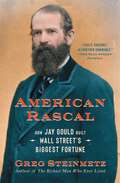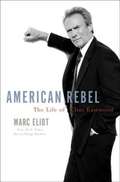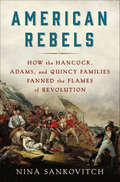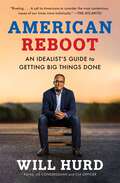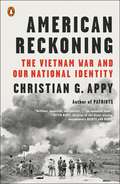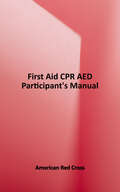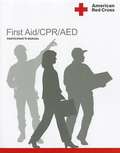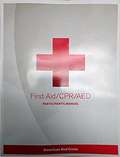- Table View
- List View
American Race Relations and the Legacy of British Colonialism
by Thomas H. StantonColonial rule distorts a colony’s economy and its society, and British rule was no exception. British policies led to a stratified American colonial society with slaves on the bottom and white settlers on top. The divided society functioned through laws that imposed rules and defined roles of the respective races. This occurred in other colonies too, often leading to strife that continues today. Especially since World War II the United States seems finally to have been able to remove many laws and practices that had created barriers between races in the divided society. Appeals to legitimacy, such as by abolitionists and the Civil Rights Movement, were essential to change laws from support of the divided society to instruments for disestablishing it. Thanks to the rule of law – another important British legacy -- the U.S. is much farther along than many former colonies in making progress. By highlighting the history of the interplay of two fundamental concepts, the divided society and the rule of law, and briefly contrasting the experiences of other former colonies, this book shows how the United States has made significant long-term progress, although incomplete, and ways for this to continue today.
American Radiance (Prairie Schooner Book Prize in Poetry)
by Luisa MuradyanWinner of the Prairie Schooner Book Prize in Poetry, American Radiance, at turns funny, tragic, and haunting, reflects on the author’s experience immigrating as a child to the United States from Ukraine in 1991. What does it mean to be an American? Luisa Muradyan doesn’t try to provide an answer. Instead, the poems in American Radiance look for a home in history, folklore, misery, laughter, language, and Prince’s outstretched hand. Colliding with the grand figures of late ’80s and early ’90s pop culture, Muradyan’s imagination pushes the reader forward, confronting the painful loss of identity that assimilation brings.
American Radical: Inside the World of an Undercover Muslim FBI Agent
by Kevin Maurer Tamer Elnoury<P>The explosive memoir of a Muslim American FBI agent fighting terror from the inside. <P>It’s no secret that federal agencies are waging a broad, global war against terror. But for the first time in this memoir, an active Muslim American federal agent reveals his experience infiltrating and bringing down a terror cell in North America. <P>A longtime undercover agent, Tamer Elnoury joined an elite counterterrorism unit after September 11. Its express purpose is to gain the trust of terrorists whose goals are to take out as many Americans in as public and as devastating a way possible. It's a furious race against the clock for Tamer and his unit to stop them before they can implement their plans. Yet as new as this war still is, the techniques are as old as time: listen, record, and prove terrorist intent. <P>Due to his ongoing work for the FBI, Elnoury writes under a pseudonym. An Arabic-speaking Muslim American, a patriot, a hero: To many Americans, it will be a revelation that he and his team even exist, let alone the vital and dangerous work they do keeping all Americans safe.
American Radical: The Life and Times of I. F. Stone
by D. D. GuttenplanPopular Front columnist and New Deal propagandist. Fearless opponent of McCarthyism and feared scourge of official liars. Enterprising, independent reporter and avid amateur classicist. As D.D. Guttenplan puts it in his compelling book, I.F. Stone did what few in his profession could—he always thought for himself. America's most celebrated investigative journalist himself remains something of a mystery, however. Born Isidor Feinstein in Philadelphia, raised in rural New Jersey, by the age of 25 this college drop-out was already an influential newsman, and enjoying extraordinary access to key figures in New Deal Washington and the friendship of important artists in New York.It is Guttenplan's wisdom to see that the key to Stone's achievements throughout his singular career—and not just in his celebrated I.F. Stone's Weekly—lay in the force and passion of his political commitments. Stone's calm, forensic, yet devastating reports on American politics and institutions sprang from a radical faith in the long-term prospects for American democracy. His testimony on the legacy of American politics from the New Deal and World War II to the era of the civil rights struggles, the Vietnam War, and beyond amounts to as vivid a record of those times as we are likely to have. Guttenplan's lively, provocative book makes clear why so many of his pronouncements have acquired the force of prophecy.
American Radicals: How Nineteenth-Century Protest Shaped the Nation
by Holly JacksonA dynamic, timely history of nineteenth-century activists—free-lovers and socialists, abolitionists and vigilantes—and the social revolution they sparked in the turbulent Civil War era“In the tradition of Howard Zinn’s people’s histories, American Radicals reveals a forgotten yet inspiring past.”—Megan Marshall, Pulitzer Prize–winning author of Margaret Fuller: A New American Life and Elizabeth Bishop: A Miracle for Breakfast On July 4, 1826, as Americans lit firecrackers to celebrate the country’s fiftieth birthday, both John Adams and Thomas Jefferson were on their deathbeds. They would leave behind a groundbreaking political system and a growing economy—as well as the glaring inequalities that had undermined the American experiment from its beginning. The young nation had outlived the men who made it, but could it survive intensifying divisions over the very meaning of the land of the free? A new network of dissent—connecting firebrands and agitators on pastoral communes, in urban mobs, and in genteel parlors across the nation—vowed to finish the revolution they claimed the Founding Fathers had only begun. They were men and women, black and white, fiercely devoted to causes that pitted them against mainstream America even while they fought to preserve the nation’s founding ideals: the brilliant heiress Frances Wright, whose shocking critiques of religion and the institution of marriage led to calls for her arrest; the radical Bostonian William Lloyd Garrison, whose commitment to nonviolence would be tested as the conflict over slavery pushed the nation to its breaking point; the Philadelphia businessman James Forten, who presided over the first mass political protest of free African Americans; Marx Lazarus, a vegan from Alabama whose calls for sexual liberation masked a dark secret; black nationalist Martin Delany, the would-be founding father of a West African colony who secretly supported John Brown’s treasonous raid on Harpers Ferry—only to ally himself with Southern Confederates after the Civil War. Though largely forgotten today, these figures were enormously influential in the pivotal period flanking the war, their lives and work entwined with reformers like Frederick Douglass, Elizabeth Cady Stanton, and Henry David Thoreau, as well as iconic leaders like Abraham Lincoln. Jackson writes them back into the story of the nation’s most formative and perilous era in all their heroism, outlandishness, and tragic shortcomings. The result is a surprising, panoramic work of narrative history, one that offers important lessons for today.
American Radio in China
by Michael A. KryskoInterwar era efforts to expand US radio into China floundered in the face of flawed US policies and approaches. Situated at the intersection of media studies, technology studies, and US foreign relations, this study frames the ill-fated radio initiatives as symptomatic of an increasingly troubled US-East Asian relationship before the Pacific War.
American Rage: How Anger Shapes Our Politics
by Steven W. WebsterAmerican Rage argues that anger is the central emotion governing contemporary US politics, with powerful, deleterious effects. Tracing the developments that have given rise to a culture of anger in the mass public, the book sheds new light on both public opinion and voting behavior. Steven W. Webster skillfully uses a combination of novel datasets, new measures of anger, and a series of experiments to show how anger causes citizens to lose trust in the national government and weaken in their commitment to democratic norms and values. Despite these negative consequences, political elites strategically seek to elicit anger among their supporters. Presenting compelling evidence, Webster ultimately concludes that elites engage in this behavior because voter anger leads to voter loyalty. When voters are angry, they are more likely to vote for their party's slate of candidates at multiple levels of the federal electoral system.
American Raiders: The Race to Capture the Luftwaffe’s Secrets
by Colonel Wolfgang W. SamuelAt the close of World War II, Allied forces faced frightening new German secret weapons—buzz bombs, V-2's, and the first jet fighters. When Hitler's war machine began to collapse, the race was on to snatch these secrets before the Soviet Red Army found them. The last battle of World War II, then, was not for military victory but for the technology of the Third Reich. In American Raiders: The Race to Capture the Luftwaffe's Secrets, Wolfgang W. E. Samuel assembles from official Air Force records and survivors' interviews the largely untold stories of the disarmament of the once mighty Luftwaffe and of Operation Lusty—the hunt for Nazi technologies. In April 1945 American armies were on the brink of winning their greatest military victory, yet America's technological backwardness was shocking when measured against that of the retreating enemy. Senior officers, including the Commanding General of the Army Air Forces Henry Harley “Hap” Arnold, knew all too well the seemingly overwhelming victory was less than it appeared. There was just too much luck involved in its outcome. Two intrepid American Army Air Forces colonels set out to regain America's technological edge. One, Harold E. Watson, went after the German jets; the other, Donald L. Putt, went after the Nazis' intellectual capital—their world-class scientists. With the help of German and American pilots, Watson brought the jets to America; Putt persevered as well and succeeded in bringing the German scientists to the Army Air Forces' aircraft test and evaluation center at Wright Field. A young P-38 fighter pilot, Lloyd Wenzel, a Texan of German descent, then turned these enemy aliens into productive American citizens—men who built the rockets that took America to the moon, conquered the sound barrier, and laid the foundation for America's civil and military aviation of the future. American Raiders: The Race to Capture the Luftwaffe's Secrets details the contest won, a triumph that shaped America's victories in the Cold War.
American Railroads
by John F. StoverFew scenes capture the American experience so eloquently as that of a lonely train chugging across the vastness of the Great Plains, or snaking through tortuous high mountain passes. Although this vision was eclipsed for a time by the rise of air travel and trucking, railroads have enjoyed a rebirth in recent years as profitable freight carriers. A fascinating account of the rise, decline, and rebirth of railroads in the United States, John F. Stover's "American Railroads" traces their history from the first lines that helped eastern seaports capture western markets to today's newly revitalized industry. Stover describes the growth of the railroads' monopoly, with the consequent need for state and federal regulations; relates the vital part played by the railroads during the Civil War and the two World Wars; and charts the railroads' decline due to the advent of air travel and trucking during the 1950s. In two new chapters, Stover recounts the remarkable recovery of the railroads, along with other pivotal events of the industry's recent history. During the 1960s declining passenger traffic and excessive federal regulation led to the federally-financed creation of Amtrak to revive passenger service and Conrail to provide freight service on bankrupt northeastern railroads. The real savior for the railroads, though, proved to be the Staggers Rail Act of 1980, which brought prosperity to rail freight carriers by substantially deregulating the industry. By 1995, renewed railroad freight traffic had reached nearly twice its former peak in 1944. Bringing both a seasoned eye and new insights to bear on one of the most American of industries, Stover has produced the definitive history of railroads in the United States.
American Railroads (Chicago History Of American Civilization Ser.)
by John F. StoverFew scenes capture the American experience so eloquently as that of a lonely train chugging across the vastness of the Great Plains, or snaking through tortuous high mountain passes. Although this vision was eclipsed for a time by the rise of air travel and trucking, railroads have enjoyed a rebirth in recent years as profitable freight carriers. A fascinating account of the rise, decline, and rebirth of railroads in the United States, John F. Stover's American Railroads traces their history from the first lines that helped eastern seaports capture western markets to today's newly revitalized industry. Stover describes the growth of the railroads' monopoly, with the consequent need for state and federal regulations; relates the vital part played by the railroads during the Civil War and the two World Wars; and charts the railroads' decline due to the advent of air travel and trucking during the 1950s. In two new chapters, Stover recounts the remarkable recovery of the railroads, along with other pivotal events of the industry's recent history. During the 1960s declining passenger traffic and excessive federal regulation led to the federally-financed creation of Amtrak to revive passenger service and Conrail to provide freight service on bankrupt northeastern railroads. The real savior for the railroads, though, proved to be the Staggers Rail Act of 1980, which brought prosperity to rail freight carriers by substantially deregulating the industry. By 1995, renewed railroad freight traffic had reached nearly twice its former peak in 1944. Bringing both a seasoned eye and new insights to bear on one of the most American of industries, Stover has produced the definitive history of railroads in the United States.
American Railroads: Decline and Renaissance in the Twentieth Century
by Robert E. Gallamore John R. MeyerOnce an icon of American industry, railroads fell into a long decline beginning around the turn of the twentieth century. Overburdened with regulation and often displaced by barge traffic on government-maintained waterways, trucking on interstate highways, and jet aviation, railroads measured their misfortune in lost market share, abandoned track, bankruptcies, and unemployment. Today, however, as Robert Gallamore and John Meyer demonstrate, rail transportation is reviving, rescued by new sources of traffic and advanced technology, as well as less onerous bureaucracy. In 1970, Congress responded to the industry's plight by consolidating most passenger rail service nationwide into Amtrak. But private-sector freight service was left to succeed or fail on its own. The renaissance in freight traffic began in 1980 with the Staggers Rail Act, which allowed railroad companies to contract with customers for services and granted freedom to set most rates based on market supply and demand. Railroads found new business hauling low-sulfur coal and grain long distances in redesigned freight cars, while double-stacked container cars moved a growing volume of both international and domestic goods. Today, trains have smaller crews, operate over better track, and are longer and heavier than ever before. Near the end of the twentieth century, after several difficult but important mergers, privately owned railroads increased their investments in safe, energy-efficient, environmentally friendly freight transportation. American Railroads tells a riveting story about how this crucial U. S. industry managed to turn itself around.
American Railway: Its Construction, Development, Management, and Trains
by Thomas Curtis ClarkeThe early history of the American railroad by the man the New York Times calls "one of the best-known civil engineers in America. ” The American Railway provides an exciting look at the railroad industry in the 1880s and how it developed as the business boomed. Originally published in 1889, it contains a thorough history of how railroads were built, the types of railways, the lives of railway workers, the various ways the railway affected political and business economics, as well as the safety precautions of people who rode or worked with the railway system. You’ll also find more than two hundred hand-drawn illustrations--visual representations of great steam engines, graceful bridges, life in a Pullman car, railway accidents, views of track construction, and portraits of railroad pioneers and magnates of the times--and stories from real rail workers. Learn how far we’ve come from such humble beginnings and grow to have a newfound appreciation for the railways that paved our country’s future. This edition features a new foreword by Jeff Smith, editor of the NRHS Bulletin, the quarterly magazine published by the National Railway Historical Society.
American Ramble: A Walk of Memory and Renewal
by Neil King“American Ramble is a dazzling mixture of travelogue, memoir, and history. At times profound, funny, and heartbreaking, this is the story of a traveler intoxicated by life. I couldn’t put it down.” — Nathaniel PhilbrickA stunning, revelatory memoir about a 330-mile walk from Washington, D.C., to New York City—an unforgettable pilgrimage to the heart of America across some of our oldest common ground. Neil King Jr.’s desire to walk from Washington, D.C., to New York City began as a whim and soon became an obsession. By the spring of 2021, events had intervened that gave his desire greater urgency. His neighborhood still reeled from the January 6th insurrection. Covid lockdowns and a rancorous election had deepened America’s divides. Neil himself bore the imprints of a long battle with cancer.Determined to rediscover what matters in life and to see our national story with new eyes, Neil turned north with a small satchel on his back and one mission in mind: To pay close attention to the land he crossed and the people he met.What followed is an extraordinary 26-day journey through historic battlefields and cemeteries, over the Mason-Dixon line, past Quaker and Amish farms, along Valley Forge stream beds, atop a New Jersey trash mound, across New York Harbor, and finally, to his ultimate destination: the Ramble, where a tangle of pathways converges in Central Park. The journey travels deep into America’s past and present, uncovering forgotten pockets and overlooked people. At a time of mounting disunity, the trip reveals the profound power of our shared ground.By turns amusing, inspiring, and sublime, American Ramble offers an exquisite account of personal and national renewal—an indelible study of our country as we’ve never seen it before.
American Rapture
by CJ LeedeThe instant USA Today bestseller from CJ Leede, author of Maeve Fly—a scorching and sweeping new novel about the end of the world as we know it.One of Esquire and Vulture's Best Horror Books of 2024 • A GoodReads and Publishers Weekly Editors' Pick • An Indie Next Pick! “A blistering, feverish ride through a uniquely American apocalypse."—Chuck Wendig, New York Times bestselling author A virus is spreading across America, transforming the infected and making them feral with lust. Sophie, a good Catholic girl, must traverse the hellscape of the midwest to try to find her family while the world around her burns. Along the way she discovers there are far worse fates than dying a virgin… The end times are coming.Also by CJ Leede:Maeve FlyAt the Publisher's request, this title is being sold without Digital Rights Management Software (DRM) applied.
American Rascal: How Jay Gould Built Wall Street's Biggest Fortune
by Greg SteinmetzThe gripping biography of Jay Gould, the greatest 19th-century robber barons, whose brilliance, greed, and bare-knuckled tactics made him richer than Rockefeller and led Wall Street to institute its first financial reforms.Had Jay Gould put his name on a university or concert hall, he would undoubtedly have been a household name today. The son of a poor farmer whose early life was marked by tragedy, Gould saw money as the means to give his family a better life…even if, to do so, he had to pull a fast one on everyone else. After entering Wall Street at the age of twenty-four, he quickly became notorious when he paralyzed the economy and nearly toppled President Ulysses S. Grant in the Black Friday market collapse of 1869 in an attempt to corner the market on gold—an event that remains among the darkest days in Wall Street history. Through clever financial maneuvers, he gained control over one of every six miles of the country&’s rapidly expanding network for railroad tracks—coming close to creating the first truly transcontinental railroad and making himself one of the richest men in America. American Rascal shows Gould&’s complex, quirky character. He was at once praised for his brilliance by Rockefeller and Vanderbilt and condemned for forever destroying American business values by Mark Twain. He lived a colorful life, trading jokes with Thomas Edison, figuring Thomas Nast&’s best sketches, paying Boss Tweed&’s bail, and commuting to work in a 200-foot yacht. Gould thrived in an expanding, industrial economy in which authorities tolerated inside trading and stock price manipulation because they believed regulation would stifle progress. But by taking these practices to new levels, Gould showed how unbridled capitalism was, in fact, dangerous for the American economy. This eye-opening history explores Gould&’s audacious exploitation of economic freedom triggered the first public demands for financial reform—a call that still resonates today.
American Realism and Naturalism
by Donald PizerDonald Pizer presents the major critical discussions of American realism and naturalism from the beginnings of the movement in the 1870s to the present. He includes the most often cited discussions ranging from William Dean Howells, Henry James, and Frank Norris in the late nineteenth century to those by V. L. Parrington, Malcolm Cowley, and Lionel Trilling in the early twentieth century. To provide the full context for the effort to interpret the nature and significance of realism and naturalism during the periods when the movements were live issues on the critical scene, however, he also includes many uncollected essays. His selections since World War II reflect the major recent tendencies in academic criticism of the movements. Through introductions to each of the three sections, Pizer provides background, delineating the underlying issues motivating attempts to attack, defend, or describe American realism and naturalism. In particular, Pizer attempts to reveal the close ties between criticism of the two movements and significant cultural concerns of the period in which the criticism appeared. Before each selection, Pizer provides a brief biographical note and establishes the cultural milieu in which the essay was originally published. He closes his anthology with a bibliography of twentieth-century academic criticism of American realism and naturalism.
American Rebel: The Life of Clint Eastwood
by Marc EliotAs an actor, he seduces us with his tough-guy charm. As a director and producer, he amazes us with his artistry and technical savvy. As a Hollywood icon, Clint Eastwood, one of film's greatest living legends, represents some of the finest cinematic achievements in the history of American cinema. In American Rebel, bestselling author and acclaimed film historian Marc Eliot examines the ever-exciting, often-tumultuous arc of Clint Eastwood's life and career. Unlike past biographers, Eliot writes with unflinching candor about Eastwood's highs and lows, his artistic successes and failures, and the fascinating, complex relationship between his life and his craft. Eliot's prodigious research reveals how a college dropout and unambitious playboy rose to fame as Hollywood' s "sexy rebel," eventually and against all odds becoming a star in the Academy pantheon as a multiple Oscar winner. Spanning decades, American Rebel covers the best of Eastwood' s oeuvre, films that have fast become American classics–Fistful of Dollars, Dirty Harry, Unforgiven, Mystic River, Million Dollar Baby, and Gran Torino. Filled with remarkable insights into Eastwood's personal life and public work, American Rebel is highly entertaining and the most complete biography of one of Hollywood's truly respected and beloved stars–an actor who, despite being the Man with No Name, has left his indelible mark on the world of motion pictures.From the Hardcover edition.
American Rebels: How the Hancock, Adams, and Quincy Families Fanned the Flames of Revolution
by Nina SankovitchNina Sankovitch’s American Rebels explores, for the first time, the intertwined lives of the Hancock, Quincy, and Adams families, and the role each person played in sparking the American Revolution.Before they were central figures in American history, John Hancock, John Adams, Josiah Quincy Junior, Abigail Smith Adams, and Dorothy Quincy Hancock had forged intimate connections during their childhood in Braintree, Massachusetts. Raised as loyal British subjects who quickly saw the need to rebel, their collaborations against the Crown and Parliament were formed years before the revolution and became stronger during the period of rising taxes and increasing British troop presence in Boston. Together, the families witnessed the horrors of the Boston Massacre, the Battles of Lexington and Concord, and Bunker Hill; the trials and tribulations of the Siege of Boston; meetings of the Continental Congress; transatlantic missions for peace and their abysmal failures; and the final steps that led to the signing of the Declaration of Independence.American Rebels explores how the desire for independence cut across class lines, binding people together as well as dividing them—rebels versus loyalists—as they pursued commonly-held goals of opportunity, liberty, and stability. Nina Sankovitch's new book is a fresh history of our revolution that makes readers look more closely at Massachusetts and the small town of Braintree when they think about the story of America’s early years.
American Reboot: An Idealist's Guide to Getting Big Things Done
by Will HurdFrom former Republican Congressman and CIA Officer Will Hurd, a bold political playbook for America rooted in the timeless ideals of bipartisanship, inclusivity, and democratic values.It&’s getting harder to get big things done in America. The gears of our democracy have been mucked up by political nonsense. To meet the era-defining challenges of the 21st century, our country needs a reboot. In American Reboot, Hurd, called &“the future of the GOP&” by Politico, provides a clear-eyed path forward for America grounded by what Hurd calls pragmatic idealism—a concept forged from enduring American values to achieve what is actually achievable. Hurd takes on five seismic problems facing a country in crisis: the Republican Party&’s failure to present a principled vision for the future; the lack of honest leadership in Washington, DC; income inequality that threatens the livelihood of millions of Americans; US economic and military dominance that is no longer guaranteed; and how technological change in the next thirty years will make the advancements of the last thirty years look trivial. Hurd has seen these challenges up close. A child of interracial parents in South Texas, Hurd survived the back alleys of dangerous places as a CIA officer. He carried that experience into three terms in Congress, where he was, for a time, the House&’s only Black Republican, representing a 71 percent Latino swing district in Texas that runs along 820 miles of US-Mexico border. As a cyber security executive and innovation crusader, Hurd has worked with entrepreneurs on the cutting edge of technology to anticipate the shockwaves of the future. Hurd draws on his remarkable experience to present an inspiring guide for America. He outlines how the Republican party can look like America by appealing to the middle, not the edges. He maps out how leaders should inspire rather than fearmonger. He forges a domestic policy based on the idea that prosperity should be a product of empowering people, not the government. He articulates a foreign policy where our enemies fear us and our friends love us. And lastly, he charts a forceful path forward for America&’s technological future. We all know we can do better. It&’s time to hit &“ctrl alt del&” and start the American Reboot.
American Reckoning
by Christian G. Appy"Few people understand the centrality of the Vietnam War to our situation as much as Christian Appy."--Ken BurnsThe critically acclaimed author of Patriots offers profound insights into Vietnam's place in America's self-image. How did the Vietnam War change the way we think of ourselves as a people and a nation? Christian G. Appy, author of the widely praised oral history of the Vietnam War Patriots, now examines the relationship between the war's realities and myths and its impact on our national identity, conscience, pride, shame, popular culture, and postwar foreign policy.Drawing on a vast variety of sources from movies, songs, and novels to official documents, media coverage, and contemporary commentary, Appy offers an original interpretation of the war and its far-reaching consequences. Authoritative, insightful, sometimes surprising, and controversial, American Reckoning is a fascinating mix of political and cultural reporting that offers a completely fresh account of the meaning of the Vietnam War.
American Reckoning: Inside Trump's Trial—and My Own
by Jonathan AlterA vivid eyewitness account of the historic first criminal trial of a president and a cri de coeur for democracy from a New York Times bestselling author and presidential historian.As one of a handful of journalists allowed in the courtroom, for 23 days Jonathan Alter sat just feet away from the most dangerous threat to democracy in American history, watching the spectacle of the century: the felony trial of Donald Trump. Highly publicized but untelevised and thus largely hidden from public view, this landmark trial offered hope of real justice amid a grueling eight-year national ordeal and foreshadowed the drama of the 2024 presidential election. Alter shares everything he witnessed—from eviscerating takes on the colorful characters to the chilling legal ups and downs—to offer a barbed account of the trial and its aftermath, including fresh reporting about the historic events of the summer of 2024. A Zelig of journalism experiencing a crisis of faith in the good sense of the American people, Alter chronicles the shaping of his political consciousness and his bracing, unpredictable relationships with Jimmy and Rosalynn Carter, Bill and Hillary Clinton, Barack Obama, John McCain, and Joe Biden, whose decision to stand down in favor of former prosecutor Kamala Harris put the criminal trial front and center as Americans rendered their own verdict at the polls. Deeply personal and passionate, American Reckoning is an eye-opening book from a journalist with a front row seat on history, offering a troubled yet hopeful look at our national moment of truth.
American Red Cross First Aid, CPR, AED Program Participant's Booklet
by American Red CrossFirst aid training booklet.
American Red Cross First Aid/ CPR/ AED Participant's Manual
by American Red CrossThe American Red Cross First Aid/CPR/AED Participant’s Manual supports the courses in the American Red Cross First Aid/CPR/AED program, to teach participants the knowledge and skills needed to give immediate care to an injured or ill person and to decide whether advanced medical care is needed. This manual contains information about recognizing an emergency, the emergency action steps, recognizing cardiac arrest, signs of a heart attack, giving CPR, the cardiac chain of survival, how to use an AED, care for choking, and care for sudden illnesses and other life-threatening injuries. As well as the information and skills needed to assist with an asthma inhaler, epinephrine auto-injector, splinting, tourniquet application, and naloxone administration. This program offers a choice of first aid, CPR and AED courses to meet the various training needs of a diverse audience. The care steps in the program are consistent with the 2020 International Liaison Committee on Resuscitation (ILCOR) Consensus on Science and Treatment Recommendations for CPR and Emergency Cardiovascular Care (ECC) and the 2020 American Heart Association and American Red Cross Guidelines for CPR and First Aid.
American Red Cross First Aid/CPR/AED Participant's Manual
by The American National Red CrossThis is the fourth edition of the American Red Cross First Aid/CPR/AED Participant's Manual. This is a revised version of the text that was previously published under the title, First Aid/CPR/AED for Schools and the Community. This manual reflects the 2010 Consensus on Science for CPR and Emergency Cardiovascular Care (ECC) and the Guidelines 2010 for First Aid.
American Red Cross First Aid/CPR/AED: Participant’s Manual
by American Red CrossThis participant's manual is part of the American Red Cross First Aid/ CPR/AED program. This manual contains three parts: 1. First Aid Basics; 2. First Aid for Cardiac Emergencies and Choking; and 3. First Aid for Common Illnesses and Injuries.
